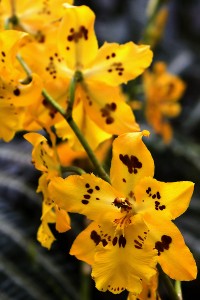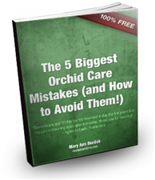 Odontoglossum orchids are well-loved for their intricately designed flowers. They bloom with colors ranging from white, yellow, red and purple, with some having colors and patterns that resemble a tiger. They thrive in cooler regions of the world and are perfect house plants (although it might be easier to control what they need in a greenhouse). They can produce several flowers at a time. The blooms can last up to six weeks or more if cared for properly.
Odontoglossum orchids are well-loved for their intricately designed flowers. They bloom with colors ranging from white, yellow, red and purple, with some having colors and patterns that resemble a tiger. They thrive in cooler regions of the world and are perfect house plants (although it might be easier to control what they need in a greenhouse). They can produce several flowers at a time. The blooms can last up to six weeks or more if cared for properly.
Like any other types of orchids, these plants need the basics – light, water, humidity and correct temperature to flourish. However, it has certain requirements that other orchids do not have. In order to successfully grow them and create the perfect environment where they can thrive, here are a few tips to follow:
1. Light. Odontoglossums thrive best under low filtered light. But this doesn’t mean they need shade year-round. Place them where light can reach them but not too much. Artificial sources of light are their best friend because they can be controlled, unlike the sun.
Greenhouses and similar structures are also the best places for these types of orchids since sunlight can be filtered to a certain amount. Never bring them out in direct sunlight, or their leaves will burn.
Check the leaves to know if proper lighting is being provided. Yellowish leaves mean they need less light and dark green leaves mean they need more. Yellow-green colored leaves are the perfect signs of adequate lighting.
2. Water and Humidity. Like most types of orchids, odontoglossums must be watered once or twice a week depending on the weather. If the temperature is hotter provide more water, and less when the temperature is colder.
The only thing you have to watch out for is when they are producing new bulbs. When a new shoot is starting to grow, provide more moisture, and go back to the regular weekly rule once it has formed completely.
The humidity levels must be between 50%-70% and not any lower than 40% or they will dry up. To support your orchids’ humidity needs, you can mist them during mornings or create a semi-humidifier. Place a tray with pebbles and water in the base of your pot and you are set to go.
3. Temperature. Odontoglossums are the type of orchids that prefer a cooler temperature for them to flourish. The reason for this is because in the wild they thrive in the high mountains of the Andes and the cool forests of Central South America. During the day the ideal temperature would be 80°F and 60°F at night.
These plants can tolerate warmer and cooler temperatures but not for a long period of time. If left under these conditions, the flowers may not completely bloom or may not bloom at all. The flowers regularly last for 6 weeks or more depending if the proper orchid care is given. Never forget to give sufficient air circulation for they love fresh air, similarly found in their natural habitats.
4. Fertilizer. Feed odontoglossums fertilizer at least once a month. Cut back every so often. A high nitrogen mixture of this proportion is best, 20:10:10. Remember to water first before you fertilize. Then at least once a month, hose down the pot to remove salt residues. Never over fertilize because this might burn the roots and the new shoots.
5. Potting and Repotting. These types of orchids are mostly classified as epiphytes. So the best potting medium for them is osmunda. Some suggest using the medium fine fir bark.
Use smaller-sized pots since they thrive best in them. Its root system loves to be confined. Add your medium 1/3 from the bottom of the pot, and then add your orchid. Spread the roots and fill it firmly with the remaining medium.
Odontoglossums need to be repotted at least once a year. Remove the old potting mixture and cut off any dead roots. You can be sure the plant is ready to be repotted by checking if a new shoot has grown roots, or if it has grown one to three inches in height.
Division must be done by potting three to five mature bulbs. Be sure to keep the medium moist until new roots have grown, and then go back to regular watering.
Knowing how to handle these conditions specifically for odontoglossums will enable you to grow the healthiest plants possible. Enjoy your orchids!
And to learn even more tips for other “favorite” orchids, check out our “Top 10 Most Popular Types of Orchids” article.




Many thanks just the advice we were looking for. Obviously we are not watering enough.
David
Great! I’m so glad this was helpful to you! Keep us updated on how you are doing. 🙂 – Mary Ann
My friend just purchased an orchid at Safeway. It has a fleshy oval thing at the base of the stem. It didn’t have a tag that said what it was, so we’re having a difficult time figuring out what it is and what care it needs. Please let me know as soon as possible!
Thank you,
Erica
Well, I’m guessing here, but does it look like this at all? I would recommend searching Google for fleshy oval, orchid, and then look at some images to see what matches. 🙂 – Mary Ann
A friend had given me odontoglossum/oncidium intergenerics specie and all the leaves are gone.I only have 2 bulbs left.They are green; so I am still hopeful that I could save this beautiful orchid.What will I do? And thank you in advance.
Hi – Try to create the conditions in this article as closely as you can. It may need to be repotted also; make sure to use a snug pot. Hopefully you will be able to save it. – Mary Ann
I purchased a Odontoglossum I was told.
It has a white stripe going down on some of the green leaves is this unusual ?
It has no name on it the grower said it was rare and to look after it. Any advice would be much appreciated as I am only new to growing this type of orchid.
Thanks. I’m not sure about the white stripes. I would highly recommend looking into a local orchid society or a nursery because it’s either perfectly normal or your orchid is infected. If it is infected, you want to give it the correct treatment ASAP. I apologize, but I am just not sure what the right answer is. Here are some guidelines on ondontoglossums from the AOS. Good luck! – Mary Ann
Regads to light requirement. do you mean if the leaves are yellow it needs less light and if too green it needs more light? Please advice thanks.
Yes! Thank you for catching that! I can’t believe I did that; I’m fixing it now. Thank you again! – Mary Ann
Thanks for your fabulous helpfùl messages I am looking at getting an odontoglosum so I will be watching your articles very carefully in future’— as always alan coulton
You’re welcome! 🙂 – Mary Ann
My odontoglossum had more and more yellow leaves,and the wider oval Base is shrinking and wrinkley. It can’t be too much light because it’s in a shaded place near but not facing a window. I may have watered it too much. Thought that as long as I let all the water drain, and its not sitting in watet, I could wayer more. Could that be it?
Many thanks, sivan
Sivan – Yes, it could be overwatering. You do need to let it drain, but you also need to make sure there’s good air flow. And you want to ensure proper humidity. Let us know how it’s going! – Mary Ann